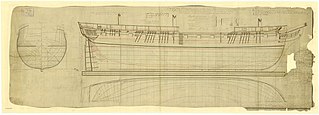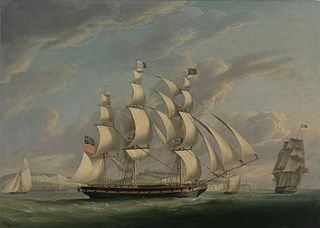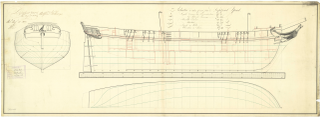
The first USS Essex of the United States Navy was a 36-gun or 32-gun sailing frigate that participated in the Quasi-War with France, the First Barbary War, and in the War of 1812. The British captured her in 1814 and she then served as HMS Essex until sold at public auction on 6 June 1837.
Ten ships of the Royal Navy have been called HMS Aurora or HMS Aurore, after the Roman Goddess of the dawn.

HMS Dryad was a fifth-rate sailing frigate of the Royal Navy that served for 64 years, at first during the Napoleonic Wars and then in the suppression of slavery. She fought in a notable single-ship action in 1796 when she captured the French frigate Proserpine, an action that would later earn her crew the Naval General Service Medal. Dryad was broken up at Portsmouth in 1860.

Bellone was a 44-gun Consolante-class frigate of the French Navy.

The Battle of Tamatave was fought off Tamatave in Madagascar between British and French frigate squadrons during the Napoleonic Wars. The action was the final engagement of the Mauritius campaign of 1809–1811, and it saw the destruction of the last French attempt to reinforce their garrison on Mauritius. Although the news had not reached Europe by February 1811 when the reinforcement squadron left Brest, Mauritius had been captured in December 1810 by a British invasion fleet, the French defences hampered by the lack of the supplies and troops carried aboard the frigate squadron under the command of Commodore François Roquebert in Renommée. Roquebert's heavily laden ships reached Mauritius on 6 May and discovered that the island was in British hands the following day, narrowly escaping a trap laid by a squadron of British frigates ordered to hunt and destroy them.
The Junon was a Gloire class 40-gun frigate of the French Navy. Launched in 1806, she saw service during the Napoleonic Wars, escorting merchant convoys to France's besieged Caribbean colonies. In February 1809 she was captured at sea after a fierce engagement with four Royal Navy vessels.

HMS Astraea was a Royal Navy 36-gun fifth rate Apollo-class frigate, launched- in 1810 at Northam. She participated in the Battle of Tamatave and in an inconclusive single-ship action with the French frigate Etoile. Astrea was broken up in 1851.
Sir John Phillimore CB was an officer of the Royal Navy who saw service during the French Revolutionary and Napoleonic Wars. He was involved in several notable actions during his active career, taking part in both Battles of Copenhagen, sending Sir Hyde Parker's famous signal to Nelson in the first, and fighting off Danish gunboats in the second. He went on to win a hard-fought victory over a French frigate in 1814 and reaped the rewards. He was at times a controversial figure, causing a scandal when he thrashed the naval historian William James with a stick for apparently badly representing Phillimore's conduct, and on another occasion inviting rebuke from the Navy Board for his request for more paint for his ship. He nevertheless became an aide-de-camp to the young Queen Victoria, and took important steps to reform how the lower ranks and ordinary seamen were treated in the Navy.

Roquebert's expedition to the Caribbean was an unsuccessful operation by a French naval squadron to transport supplies to Guadeloupe in December 1809 at the height of the Napoleonic Wars. Over the previous year, British Royal Navy squadrons had isolated and defeated the French Caribbean colonies one by one, until by the autumn Guadeloupe was the only colony remaining in French hands. Cut off from the rest of the world by British blockade squadrons that intercepted all ships coming to or from the island, Guadeloupe was in a desperate situation, facing economic collapse, food shortages and social upheaval, as well as the impending threat of British invasion. In an effort to reinforce and resupply the colony, the French government sent four vessels to the West Indies in November 1809 under Commodore François Roquebert. Two of the ships were 20-gun flûtes carrying supplies and troops. The two others were 40-gun frigates, ordered to protect the storeships on their journey from the British forces operating off both the French and Guadeloupe coasts.

HMS Epervier was an 18-gun Cruizer-class brig-sloop of the Royal Navy, built by Ross at Rochester, England, and launched on 2 December 1812. USS Peacock captured her in 1814 and took her into service. USS Epervier disappeared in 1815 while carrying dispatches reporting the signing of a treaty with the Dey of Algiers.
Vincent-Marie Moulac was a French naval officer and privateer.
The French brig Observateur, which was launched in 1800 for the French Navy, was a Vigilant-class 16-gun brig, one of six built to a design by Pierre-Alexandre-Laurent Forfait. The Royal Navy captured her in 1806 and took her into service as HMS Observateur. She participated in two actions, one for the French Navy and one for the Royal Navy, and one campaign before she was laid up in 1810. The Navy did not succeed in selling her until 1814.
The Loire-class flûte was a French Navy class of two 20-gun flûtes that Louis, Antoine, and Marhurin Crucy, Basse Indre, built to a design by François-Louis Etesse, and under a contract dated 5 November 1802.
HMS Challenger was a Cruizer-class brig-sloop launched at Redbridge, Southampton, in 1813. She participated in the capture of a French privateer and then sailed to the East Indies. She was laid up in 1819 and sold in 1824.
Blenden Hall was a full-rigged ship, launched in 1811 at Bursledon, Hampshire, England. A French frigate captured her in 1813, but then abandoned her. After her recovery she returned to trade. She was wrecked in 1821 on Inaccessible Island in a notable incident.
Lusitania was a British merchant vessel launched in 1804. She emerges from the general background for two notable events in her history, one in 1813 when the French Navy captured and released her, and then between 1826 and 1830 for a whaling voyage. She was probably wrecked in 1834.

John O'Gaunt was a merchant ship launched in 1809 that traded with the West Indies. The French frigate Clorinde captured and scuttled John O'Gaunt in 1813.
HMS Horatio was a Royal Navy 38-gun fifth-rate Lively-class frigate, built out of fir timbers at the yard of George Parsons in Bursledon.

Milan was a French brig built at Saint Malo, from plans designed by François Pestel that had already served for Curieux in 1800 and for Palinure in 1804. She served in the French Navy for four years before HMS Surveillante and Seine captured her. She became HMS Achates in the Royal Navy and served until after the end of the Napoleonic Wars.
Townshend Packet was launched at Falmouth in 1800 as a packet for the Post Office Packet Service. She made numerous voyages between Falmouth and Lisbon and also sailed to the West Indies, Brazil, and the Mediterranean. She had two engagements with American privateers. In the first the Americans captured her, but then released her. In the second she repelled her attacker. A French frigate captured her in 1814 and then sank her.










